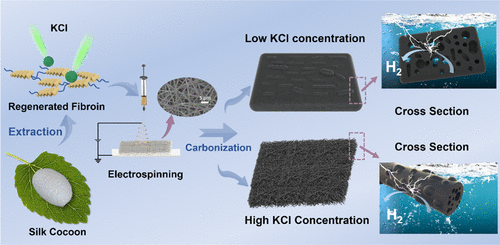当前位置:
X-MOL 学术
›
ACS Appl. Mater. Interfaces
›
论文详情
Our official English website, www.x-mol.net, welcomes your
feedback! (Note: you will need to create a separate account there.)
Porous Carbon Nanofibers Derived from Silk Fibroin through Electrospinning as N-Doped Metal-Free Catalysts for Hydrogen Evolution Reaction in Acidic and Alkaline Solutions
ACS Applied Materials & Interfaces ( IF 8.3 ) Pub Date : 2021-12-28 , DOI: 10.1021/acsami.1c19334 Hongzhe He 1 , Yan Zhang 1 , Wenqin Zhang 1 , Yuanyuan Li 1 , Xing Zhu 2 , Ping Wang 1 , Dongmei Hu 3
ACS Applied Materials & Interfaces ( IF 8.3 ) Pub Date : 2021-12-28 , DOI: 10.1021/acsami.1c19334 Hongzhe He 1 , Yan Zhang 1 , Wenqin Zhang 1 , Yuanyuan Li 1 , Xing Zhu 2 , Ping Wang 1 , Dongmei Hu 3
Affiliation

|
Water electrolysis is considered as one promising strategy for hydrogen production, and thus, preparing electrocatalysts of superior efficiency and low cost for a hydrogen evolution reaction (HER) in a wide pH range is of paramount importance. In this research, N-doped porous carbon nanofibers derived from silk fibroin by KCl chemical activation are successfully synthesized as the metal-free catalyst for the HER under both acidic and alkaline conditions. After chemical activation of KCl, hierarchical porous structures are formed. Besides, it is found that the concentration of KCl in the electrospun membrane will affect the maintenance of the fibrous morphology for the carbonized samples due to the destruction of β-sheets in silk fibroin induced by KCl. The specific surface area of the optimized sample, 4%-SPCNF, increased by nearly nine times compared with that without activation because of the hierarchical pores and large through pores between fibers. Meanwhile, the porosity increases from 59.87 to 80.28% due to the existence of through pores. Moreover, the 4%-SPCNF has remarkable stability and durability since the carbon substrate is resistant against the corrosion of the electrolyte. Our work provides insights into the design and engineering of silk fibroin-derived carbon nanofibers for metal-free catalysts of the HER under acidic and alkaline conditions.
中文翻译:

通过静电纺丝衍生自丝素蛋白的多孔碳纳米纤维作为酸性和碱性溶液中析氢反应的 N 掺杂无金属催化剂
水电解被认为是一种很有前景的制氢策略,因此,制备在宽 pH 范围内用于析氢反应 (HER) 的高效且低成本的电催化剂至关重要。在这项研究中,通过 KCl 化学活化从丝素蛋白衍生的 N 掺杂多孔碳纳米纤维成功地合成了作为酸性和碱性条件下 HER 的无金属催化剂。KCl 化学活化后,形成分级多孔结构。此外,由于KCl诱导丝素蛋白中β-折叠的破坏,发现电纺膜中KCl的浓度会影响碳化样品的纤维形态的维持。优化后样品的比表面积,4%-SPCNF,由于纤维间的分层孔隙和较大的通孔,与未激活相比增加了近9倍。同时,由于通孔的存在,孔隙率从59.87%增加到80.28%。此外,4%-SPCNF 具有显着的稳定性和耐用性,因为碳基材能够抵抗电解质的腐蚀。我们的工作为在酸性和碱性条件下用于 HER 无金属催化剂的丝素蛋白衍生碳纳米纤维的设计和工程提供了见解。4%-SPCNF 具有显着的稳定性和耐用性,因为碳基材能够抵抗电解液的腐蚀。我们的工作为在酸性和碱性条件下用于 HER 无金属催化剂的丝素蛋白衍生碳纳米纤维的设计和工程提供了见解。4%-SPCNF 具有显着的稳定性和耐用性,因为碳基材能够抵抗电解液的腐蚀。我们的工作为在酸性和碱性条件下用于 HER 无金属催化剂的丝素蛋白衍生碳纳米纤维的设计和工程提供了见解。
更新日期:2022-01-12
中文翻译:

通过静电纺丝衍生自丝素蛋白的多孔碳纳米纤维作为酸性和碱性溶液中析氢反应的 N 掺杂无金属催化剂
水电解被认为是一种很有前景的制氢策略,因此,制备在宽 pH 范围内用于析氢反应 (HER) 的高效且低成本的电催化剂至关重要。在这项研究中,通过 KCl 化学活化从丝素蛋白衍生的 N 掺杂多孔碳纳米纤维成功地合成了作为酸性和碱性条件下 HER 的无金属催化剂。KCl 化学活化后,形成分级多孔结构。此外,由于KCl诱导丝素蛋白中β-折叠的破坏,发现电纺膜中KCl的浓度会影响碳化样品的纤维形态的维持。优化后样品的比表面积,4%-SPCNF,由于纤维间的分层孔隙和较大的通孔,与未激活相比增加了近9倍。同时,由于通孔的存在,孔隙率从59.87%增加到80.28%。此外,4%-SPCNF 具有显着的稳定性和耐用性,因为碳基材能够抵抗电解质的腐蚀。我们的工作为在酸性和碱性条件下用于 HER 无金属催化剂的丝素蛋白衍生碳纳米纤维的设计和工程提供了见解。4%-SPCNF 具有显着的稳定性和耐用性,因为碳基材能够抵抗电解液的腐蚀。我们的工作为在酸性和碱性条件下用于 HER 无金属催化剂的丝素蛋白衍生碳纳米纤维的设计和工程提供了见解。4%-SPCNF 具有显着的稳定性和耐用性,因为碳基材能够抵抗电解液的腐蚀。我们的工作为在酸性和碱性条件下用于 HER 无金属催化剂的丝素蛋白衍生碳纳米纤维的设计和工程提供了见解。















































 京公网安备 11010802027423号
京公网安备 11010802027423号